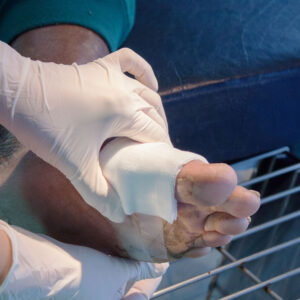Toenail Fungus
Treatment and Diagnosis at Vale Foot and Ankle
Fungus on toenails is more than a cosmetic issue. It can be a serious concern that will only progress if not treated. Whether it’s causing thickening, discoloration, brittleness, or pain associated with your nails, rest assured that the qualified staff at Vale Foot and Ankle can help treat your toenail fungus infection.
Our caring podiatrists specialize in both early and late-stage treatment for fungal nail infection. If you have been battling with a toenail fungus infection with limited success using home remedies, then we can assist you with clinical treatment.

What is Toenail Fungus?
Onychomycosis, or toenail fungus, is a fungal infection of the nail and nail bed. It usually starts as a white or yellowish speck under a toenail, then spreads deeper into the nail, possibly causing it to thicken, discolor, become brittle, or even misshape.
It is caused by dermatophytes, fungi that grow in warm and humid environments. Yeasts and molds may also take part in this process. It can involve one or several nails; if it is not cured properly, it tends to recur.
Common Signs and Symptoms
Toenail fungus is often painless, but it can cause visible and structural changes to the toenail. You might notice:
- Yellow, brown, or white discoloration
- Thickening of the nail
- Crumbly, brittle, or ragged edges
- Distorted shape
- A foul odor
- Separation of the nail from the nail bed, in advanced cases
The skin surrounding the ingrown toenail may become irritated or infected, especially in diabetic patients and those with circulatory problems.
Professional Treatment Options for Toenail Fungus
At Vale Foot and Ankle, we offer several clinical-grade treatments depending on the severity of the infection and your overall health.
Topical medications will work on both the nail and the skin surrounding it. These medications can only be used on nail infections that are in their early stages.
For more persistent cases, oral antifungal medications may be indicated to help clear the infection from the inside out. Treatment usually lasts 6–12 weeks and requires periodic monitoring.
Trimming, thinning, or avulsion of the infected part of the nail decreases pressure and permits better penetration of topical agents.
Sometimes, when there is severe damage to the nail or infection, we might have to advise a partial or complete removal of the toenail to allow for its healthy regrowth.
How Toenail Fungus Spreads
Fungus infections of the nails are contagious and can be spread between the toes and from person to person when sharing environments. You are more likely to develop toenail fungus if:
- Go barefoot in public showers, locker rooms, or pool areas
- Wearing tight shoes or sweaty socks for extended periods of time
- Have a history of athlete’s foot or nail injury
- Have diabetes or poor immune function
- Use shared nail salons or instruments that are not properly sanitized
Prevention and good hygiene of the foot can go a long way in reducing the risk of infection.


Tips to Avoid Recurrence
After treatment has succeeded, continued care can help prevent toenail fungus from coming back:
- Keep the feet dry and clean
- Wearing socks every day and changing shoes
- Wearing flip-flops in communal areas
- Disinfecting your nail tools at home
- Do not use nail polish during treatment for an infection
- Wearing breathable footwear.
We will walk you through a personalized prevention plan that will work for your lifestyle.
Why Choose Vale Foot and Ankle for Toenail Fungus Treatment?
We know toenail fungus can be frustrating and sometimes embarrassing. At Vale Foot and Ankle, we approach treatment with sensitivity and precision, offering care that gets results without judgment. And as a surgical podiatry practice, we’re able to manage even the most complex or stubborn infections without referring you elsewhere.
Get Local Help for Toenail Fungus in Connecticut
If you have been dealing with problems such as thick and discolored nails or symptoms of fungal infection, do not wait. Contact us today.
We can help you feel more confident in your footsteps and in your bare feet.
Latest Posts

Tailor’s Bunion (Bunionette) Stages
A tailor’s bunion, also known as a bunionette, may seem like a small foot problem,

Pediatric Heel Pain: Symptoms, Causes, and Treatment
Children’s heel pain is common and typically treatable, but can be frustrating to daily activities,

Diabetic Foot Ulcers: Treatment, Prevention, and Care
For diabetics, foot care is not a luxury but a way to prevent serious medical
